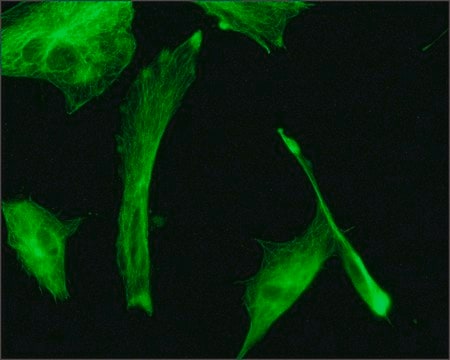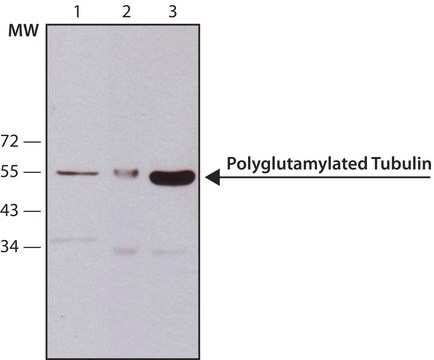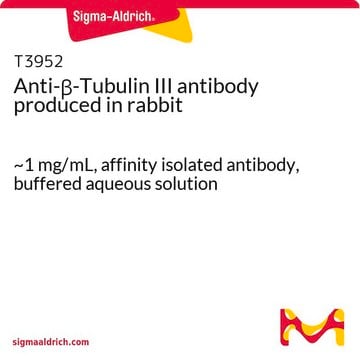T0198
Anti-β-Tubulin antibody, Mouse monoclonal
clone D66, purified from hybridoma cell culture
Synonyme(s) :
Anti-Tubulin beta-1 chain
About This Item
Produits recommandés
Source biologique
mouse
Niveau de qualité
Conjugué
unconjugated
Forme d'anticorps
purified immunoglobulin
Type de produit anticorps
primary antibodies
Clone
D66, monoclonal
Forme
buffered aqueous solution
Poids mol.
antigen ~50 kDa
Espèces réactives
human, bovine, chicken, rat, canine, Chlamydomonas reinhardtii, sea urchin (Lytechinus pictus and Paracentrotus lividus), mouse, hamster, Oxyrrhis marina (dinoflagellate), rabbit, monkey
Conditionnement
antibody small pack of 25 μL
Concentration
~1 mg/mL
Technique(s)
immunocytochemistry: suitable (3% paraformaldehyde-0.5% Triton X-100 and methanol-acetone)
immunoprecipitation (IP): suitable
indirect ELISA: suitable
western blot: 0.5-1.0 μg/mL using whole extract of cultured rat adrenal pheochromocytoma (PC-12) cells
Isotype
IgG1
Numéro d'accès UniProt
Conditions d'expédition
dry ice
Température de stockage
−20°C
Modification post-traductionnelle de la cible
unmodified
Informations sur le gène
human ... TUBB1(81027) , TUBB2A(7280) , TUBB2C(10383)
mouse ... Tubb1(545486) , Tubb2a(22151) , Tubb2c(227613)
rat ... Tubb2(29212) , Tubb2c(296554)
Description générale
Spécificité
Immunogène
Application
Actions biochimiques/physiologiques
Forme physique
Clause de non-responsabilité
Not finding the right product?
Try our Outil de sélection de produits.
En option
Code de la classe de stockage
10 - Combustible liquids
Classe de danger pour l'eau (WGK)
WGK 3
Point d'éclair (°F)
Not applicable
Point d'éclair (°C)
Not applicable
Certificats d'analyse (COA)
Recherchez un Certificats d'analyse (COA) en saisissant le numéro de lot du produit. Les numéros de lot figurent sur l'étiquette du produit après les mots "Lot" ou "Batch".
Déjà en possession de ce produit ?
Retrouvez la documentation relative aux produits que vous avez récemment achetés dans la Bibliothèque de documents.
Les clients ont également consulté
Articles
Microtubules of the eukaryotic cytoskeleton are composed of a heterodimer of α- and β-tubulin. In addition to α-and β-tubulin, several other tubulins have been identified, bringing the number of distinct tubulin classes to seven.
Notre équipe de scientifiques dispose d'une expérience dans tous les secteurs de la recherche, notamment en sciences de la vie, science des matériaux, synthèse chimique, chromatographie, analyse et dans de nombreux autres domaines..
Contacter notre Service technique















